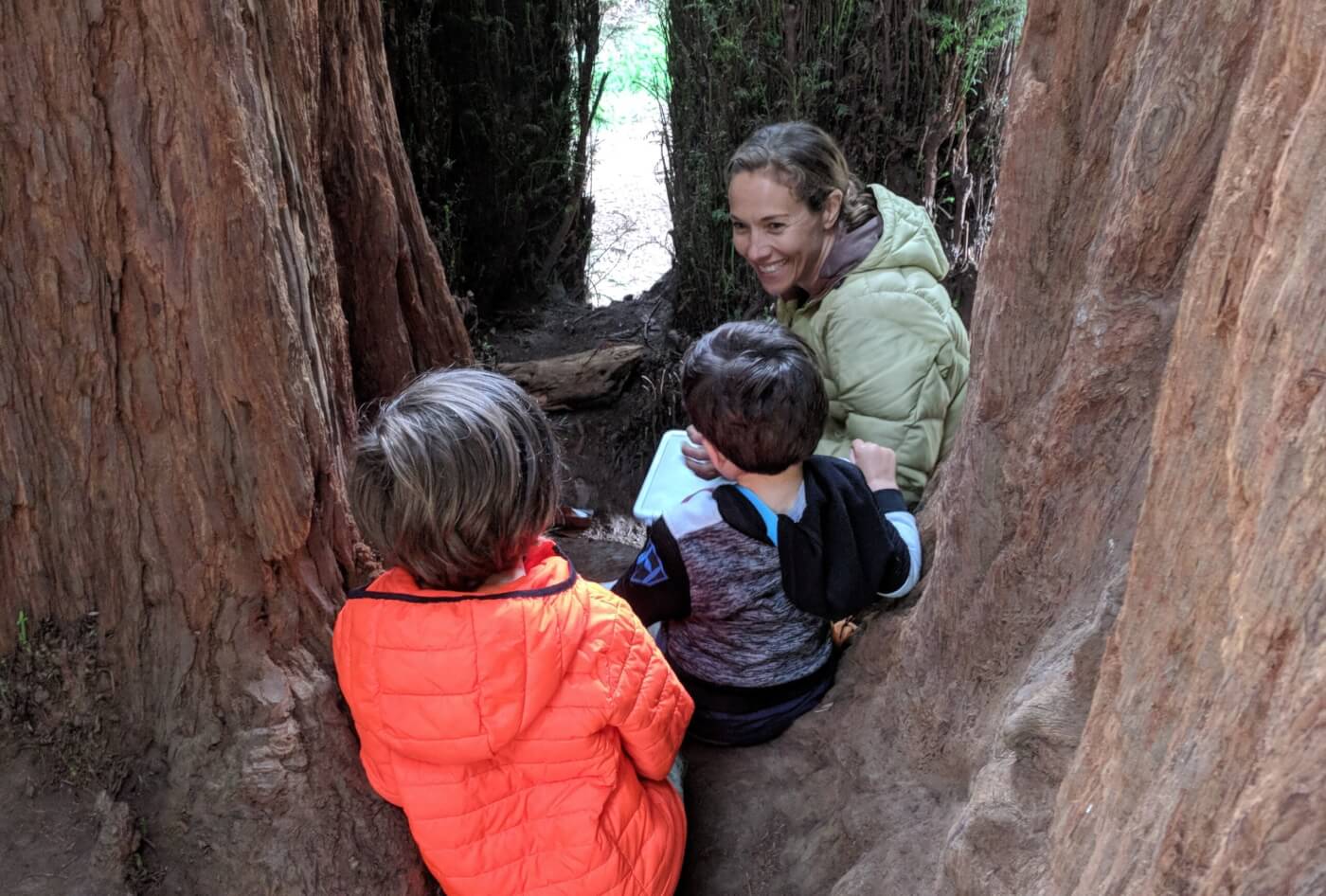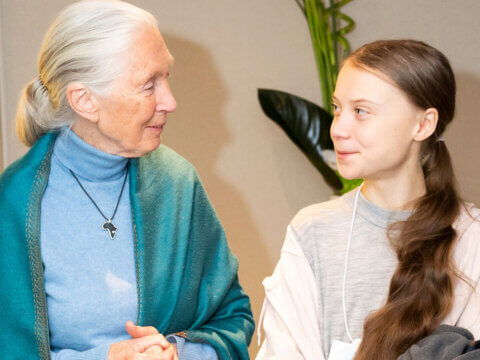Neurodiversity in nature: Occupational therapy in the outdoors helps children find confidence
The moment came just a few weeks into Nick’s* participation in outdoor OT sessions. Nick’s mom was chatting with Laura Park Figueroa, who led Nick’s sessions. Suddenly, Nick climbed up onto a small wooden beam nearby and calmly walked across the beam all by himself. Nick’s mother was overcome with emotion after seeing her son’s confidence and excitement. What might have seemed like a small action was actually a huge show of bravery for Nick and a significant moment of joy for his mother.
As a young child, Nick was diagnosed with dyspraxia, a disorder that affects coordination and movement. He was often hesitant and afraid of new challenges, and Nick’s mother was eager to find support for her son. Enter Figueroa, the CEO and founder of Outdoor Kids Occupational Therapy. Figueroa began to work with Nick in one of her Outdoor Kids occupational therapy (OT) groups. Outside, in nature, she observed how Nick would cry if the tiniest bit of mud got on him, and she noticed how fearful Nick was of climbing or engaging in play activities with his small group.
Nick’s balance beam act was a major breakthrough.

Laura Park Figueroa modulates sensory input for each child’s individualized needs, based on results of the child’s occupational therapy assessment.
“When kids engage in therapy outdoors, they get a confidence from braving these real-life challenges that nature provides, that we can’t mimic in an indoor setting,” said Figueroa. “I call nature my blameless co-therapist. In nature-based therapy sessions, nature can challenge kids. Maybe we’re muddy, or maybe a tree fell and we can’t hike in a certain direction, but at that moment, the child doesn’t blame nature. Instead, they have to adapt.”
Pediatric occupational therapists are holistic child development specialists who assess children’s skills, environments and routine tasks to identify barriers getting in the way of the child playing, learning and participating in daily life. Occupational therapy, or OT, aims to eliminate those barriers by supporting the child’s development, changing the environment or modifying tasks to fit the child’s unique needs. The main goal of OT is to make daily life easier and more enjoyable for the child and caregivers.
Outdoor Kids Occupational Therapy was founded on the idea that nature challenges and inspires children in a way that is impossible to replicate in an indoor setting. In 2015, Figueroa was working with kids indoors as a traditional occupational therapist when she decided to start working with her clients outside in nature. Figueroa said she wasn’t convinced that the conventional occupational therapy method for children was as effective as it could be.
As an occupational therapist, Figueroa would assess a child’s areas of need and develop a treatment plan to help them with their activities at home and school, like developing fine motor skills or learning how to connect with other kids. But the problem was, the sessions often occurred indoors with the therapist working one on one with the child. Instead, she envisioned a version of occupational therapy where children could connect with their peers in a small group setting and learn how to build relationships and communicate — while outdoors.

Children work together to problem solve how to create a fort using large sticks during an outdoor group OT session. The therapist addresses children’s social-emotional and motor goals throughout this small-group experience.
“I thought, ‘How are we addressing social skills with kids as just the therapist and child, indoors, in a room alone?'” said Figueroa. “If we believe in play-based approaches and supporting children’s social participation, developing their relationships and motor skills, then the evidence is clear that nature-based therapy supports all these areas that OTs are concerned about.”
At the same time Figueroa was working with clients outdoors, she was also researching the most effective methods for working with neurodivergent kids outdoors. The term “neurodivergent” is often used to describe people whose brains work differently or in ways that are not considered “typical.” People who experience ADHD, autism, sensory disorders or learning difficulties may identify as neurodivergent.
In her practice, Figueroa observed that small-group sessions in the outdoors seemed to have a positive effect on the behavior of her neurodivergent clients. The same children who would typically become overwhelmed or frustrated when indoors could more easily connect with other kids and be more flexible with their thinking during small-group outdoor sessions. At times when conflict did arise, the small-group setting allowed the therapist to provide children with individualized support to navigate conflict and teach the child strategies for managing big emotions. Figueroa also noted that nature offered children a multitude of opportunities for practicing self-regulation during treatment sessions.

Two children work together to carry firewood during an outdoor OT session. This experience provides proprioceptive input, also known as “heavy work,” giving deep input to joints and calming the children’s nervous systems, while also allowing the children to work as partners together to help the group.
Through this work, Figueroa developed a practice model called the ConTiGO Approach. “ConTiGO” stands for CONnection and Transformation In the Great Outdoors. The practice model encourages pediatric therapists to blend evidence-based interventions with nature to help neurodivergent children meet their therapy goals.
Figueroa embarked on a Ph.D program to continue researching the best practices for outdoor therapy. During this program, she found plenty of research supporting the idea that time outdoors benefits overall mental, physical and social-emotional health of children. However, she found very little research focused on how to conduct outdoor pediatric therapy for neurodivergent children.
With this in mind, Figueroa began conducting her own research on outdoor occupational therapy for children with disabilities. After interviewing more than 20 nature-based occupational therapists and analyzing more than 500 pages of interview transcripts, Figueroa developed a theoretical model called the Ecology of Change in Outdoor Therapy, or ECO-Therapy Model. The ECO-Therapy Model aims to explain how change occurs during outdoor therapy with children. She is now in the process of submitting her work for publication.

Occupational therapists may provide specific cues to allow a child to complete tasks as independently as possible while maintaining safety. Here, Figueroa provides a tactile cue to the child’s back to help him stabilize his shoulder to effectively and efficiently use the saw during an outdoor session.
“If we’re being child-centered and engaging kids, then it should look like play, but a lot is going on behind the scenes in the therapists’ brain to make sure that we’re challenging the child depending on the goals for that session,” said Figueroa. “OT is an art and a science. As OTs, we do holistic assessment of a child’s development and look at all of the contextual factors that may be influencing a child’s participation in daily life. We are very good at analysis and our knowledge of the nervous system and how that influences a child’s behavior.”
According to Figueroa, an outdoor OT session is planned with specifically chosen activities to address the individual therapy goals of each child. Outdoor occupational therapy might look like kids working on hand strength and fine motor skills by making leaf confetti or participating in a group hide-and-seek game where kids interact with each other and nature.

Occupational therapists often utilize a variety of swings to provide different types of vestibular input. Here, an affordable and durable PVC pipe was used to design a swing with the children.
“We bring a plan to the session in nature-based OT, but you have to be willing to follow the child’s lead and change things in the moment based on your analysis as an OT,” said Figueroa. “Our goal is to give the child the ability to adapt while still in a safe environment.”
The response to Figueroa’s ConTiGO approach by parents and occupational therapists has been overwhelmingly positive. Parents feel like nature-based OT gives their children a chance to work on their goals in a supportive setting that doesn’t feel like a medical clinic.
“It’s so natural. He’s much more confident. Even at school we’re starting to see him play with other kids. He’s more free in his movement, more coordinated,” said Kimberly and Carmen, parents of a 5-year-old Outdoor OT client. “This doesn’t feel like work, and that’s why it works. It’s hard to imagine OT in any other way now.”

A small-group setting for nature-based therapy allows children to learn to listen to their peer’s requests while playing a ball game in the swing, facilitated by the occupational therapist.
To help train and support other pediatric therapists, Figueroa also began a second business, Therapy in the Great Outdoors (TGO). The TGO Community is a place for pediatric therapists (of all kinds!) to connect and learn about nature-based therapy for children. TGO also offers the ConTiGO Approach online course and business coaching for nature-based therapists. According to Figueroa, more than 100 pediatric therapists worldwide have taken the ConTiGO Approach training course, designed to help pediatric therapists practice nature-based therapy. And that’s just the beginning. A searchable directory of therapists who are certified in the ConTiGO Approach is in development. The directory will allow caregivers and families to find nature-based practitioners in their communities. It is expected to launch at the end of March 2023.
“As parents, we long for our kids to have positive experiences. We don’t want them to feel like they are different or awkward being in therapy,” said Figueroa. “Nature-based therapy gives parents a place to bring their child that feels like a real-life setting — it feels like play. Nature brings this supportive and challenging environment to therapy. It’s astounding the confidence that kids get when engaging in therapy outdoors.”
*Please note, the name of the child has been changed for this article.
5 Comments
Submit a Comment
Visit the websites for Outdoor Kids Occupational Therapy and Therapy in the Great Outdoors, Laura Park Figueroa’s two organizations bringing nature-based therapy to children everywhere
Read scientific studies about the benefits of nature for neurodivergent children, in our Research Library
Read scientific studies about the ways that nature connection improves social-emotional function, in our Research Library
For more about the role that nature can play in health care, check out the Finding Nature News feature “Giving patients the power to self-prescribe nature,” about Park Rx America’s mission to bring nature prescriptions to children (and adults) all over the world
-
Feature
GROWING POWER: Urban Roots connects young people with natural spaces, food systems – and one another
-
Feature
Nature photographer Dudley Edmondson has a vision for the representation of Black and Brown faces in the outdoors
-
Network News
Community Spotlight: Prescribe Outside
-
Richard Louv
SPRING FORWARD! 12 Ways to Make Sure Your Kids (and You) Get the Right Dose of VITAMIN N this Spring — and Summer, Too
-
Voices
Placemaking: How to build kinship and inclusive park spaces for children with disabilities







This superb article highlights what all of us who work with students should continually consider. Ultimately, it’s about what is best for the child and what is best suited to support their development. Amber did a fantastic job of conveying the heart behind this mode of therapy. May many more take cues from this article and expand the ways we interact with and support neurodivergent (really all) children.
This article is dear to my heart as a mother to a son on the spectrum and I thank you for your work and for sharing your article with the public.
I am transitioning from a career as an education and interpretation program manager (federal civil servant) to a community servant in my home state of Texas. I have a multi-faceted long-range plan that includes a community garden (teaching: soil preparation, irrigation, planting, harvesting, food nutrition/preparation). The target audience is youth who are not adjusting to the norms of our society and are finding themselves in trouble (legal/family). I had not considered opening this opportunity to youth who may be considered neurodivergent and to include occupational Therapist and other therapists in my planning. Other target groups include senior citizens and individuals needing vegetables/fruits or a meal.
I would be very grateful for additional materials and group contacts that will optimize this community project planning benefit as many people in our community as possible.
There is no greater joy than to provide positive opportunities for others to grow spiritually, emotionally, and intellectually. Thank you!
Dora, that sounds amazing! I wish you the best!!
Amber, thank you so much for this informative article! I am an outdoor/nature preschool teacher (in MA). I often have children who need OT. I currently have two OT doctoral students completing an internship in my class. I’m excited to share this with them and to collaborate on creating OT experiences in nature!
I am a pediatric OT over 40 years and this is the first time hearing of this!! Ms Figueroa describes OT’s role perfectly and how her approach works so well in our profession. Activity to engage the mind and hands is therapeutic and even more so in a natural environment. I am eager to learn more about the ConTiGo Approach. Such a well written aritcle, Amber! Thank you!